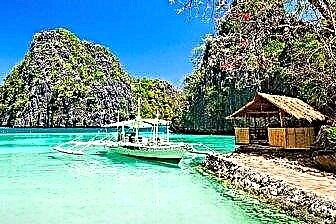Lille is a border city located 14 km from Belgium. Many historical events of different centuries are associated with it, which affected local attractions. Charles de Gaulle was born here - the President of France, who changed the colonial policy of the country. A square is named in his honor, and there is also a museum headed by the de Gaulle foundation.
The architecture reflects the characteristics of different eras. Churches, the Old Exchange and other buildings are often historical monuments or World Heritage sites. The citadel still remains an active military facility, but the "Countess's Hospital" has turned into a museum. Football fans will not pass by the home stadium of the Lille club, and little travelers and their parents will definitely like it in the cozy city zoo.

The best hotels and hotels at affordable prices.
from 500 rubles / day
What to see and where to go in Lille?
The most interesting and beautiful places for walking. Photos and a short description.
General de Gaulle square
The central square of the city. It has several names, including the Big Square and the Goddess Square. The latter name is explained by the presence of a fountain with a column, which depicts a female figure with an artillery fuse in her hands. The official name is given in honor of the first President Charles de Gaulle, who was born in Lille. Here is the building of the Old Exchange, and a little further - the opera house.

Old exchange
Built in the middle of the 17th century. The architectural style is Flemish. The author of the project is Julien Destré. The complex consists of 24 absolutely identical houses. Decorative trimmings, columns, stucco molding - all this is in abundance. In the past, fierce bargaining took place here. The courtyard is now a place where flowers are sold and dance evenings are held. Recognized as a historical monument in 1921.

Paris gate
Erected at the end of the 17th century. Their appearance was associated with the conquest of Lille by King Louis XIV. He ordered to build a gate in the place where the destroyed fortifications stood. The structure is a massive arch with baroque features. It is decorated with sculptures of ancient gods and heroes. Attractions nearby: the town hall and the Ghent hospital, which has become an upscale hotel.

City hall
Built in the first half of the 20th century. Became a replacement for the old town hall, destroyed during the war. The author of the project is Emil Dubisson. The main materials are reinforced concrete and red brick. A bell tower, the largest in Europe, was erected nearby. Height - 104 meters. The columns at the base are sculptured. Another feature is a powerful searchlight, the beam of which, according to rumors, “finishes off” to Belgium. It is listed as a UNESCO World Heritage Site.

Lille Chamber of Commerce
The Louis-Marie Cordonnier project was completed in about 11 years by 1921. Many organizations that were previously based in the building of the Old Exchange moved here. The facade has many decorative details, but they are unobtrusive. Thanks to the bell tower, the total height of the structure is 76 meters. A distinctive ringing sound is heard every 15 minutes. The Chamber of Commerce received the status of a historical monument in 2016.

Opera theatre
Louis Marie Cordogne was in charge of the project. He won the competition to build a new opera house and completed the work by 1913. The architectural style is neoclassical. The roof and facade are decorated with sculptures. The First World War delayed the opening by 10 years, although the performances were unofficially staged. In 2003, after a major renovation, the building again became available to the public. The auditorium has about a thousand seats.

Cathedral of Notre Dame de la Trey
Laid down in 1854, construction lasted for a century and a half. The architectural style is neo-gothic. The roof is assembled from marble panels, and the stained-glass window of the facade was painted by Ladislas Kiino, a renowned contemporary artist. The height of the bell tower of the cathedral is about 100 meters, which makes it possible to notice the structure from different points of the city. Dedicated to the Basilica of the Virgin Mary, inside there is a statue of her dating from the XII century.

Church Saint Maurice
Or the Church of St. Mauritius. Construction began in the 14th century and ended only 5 centuries later. This also affected the appearance: different architects brought in their own details. Initially, the cathedral was supposed to receive the status of a cathedral, but competitors were ahead of it. Philippe Cannisier finished the project, which made it more harmonious. The main value is the monstrance of St. Mauritius.

Lille Citadel
The construction was completed in a few years by 1671. The design was carried out by the Marquis de Vauban. Has a pentagonal shape. When attacking one wall, the enemy was under fire from the other. Although the citadel is unique in its characteristics, it is not included in the UNESCO World Heritage List. The reason is that the fortress is still an active military facility.

Lille Metropolitan Museum of Contemporary Art
Located in the Villeneuve d'Asca park. The main direction - objects of art from the beginning of the XX century to the present day. The number of exhibits is approaching 5 thousand. In 2002, a new wing was added to the museum building. The exposition area occupies 4 thousand square meters. The collection includes works by Modigliani, Picasso, Calder. The art brut collection is the largest in France. The museum has an extensive library.

Palace of Fine Arts
The year 1792 can be considered the basis. The current collection originates from the gallery of the artist Louis Watteau, located in the academy of painting. The exhibition included 30 paintings. In 1809, a new program for the popularization of art allowed the exhibition to expand many times over. Later sculptures, coins, ceramics were added to the painting. The exhibitions are currently being held in two buildings on Republic Square.

Museum "Hospital Countess"
Alternative name - "Almshouse". It has existed in the city since the beginning of the 13th century. Countess Zhanna Konstatinopolskaya founded a hospital for the poor and supported it. Several renovations have changed the original appearance of the building. Later, a shelter was located here. At the turn of the 60s and 70s of the last century, the former hospital became a museum in Flanders. The exposition tells about the history, culture and art of the region.

Lille Natural History Museum
Founded in 1822, the funds contain more than 500 thousand exhibits. The Museum has sections for many sciences, including geology, zoology, botany, ethnography. One of the mini-exhibitions is dedicated to the industry of Lille: from its inception to the present day. The current building was set aside for the exhibition in 1902. New details are constantly added to the excursion tour, and it is not complete without an interactive component.

House-Museum of Charles de Gaulle
Opened in 1983. The building belongs to the foundation named after the first president of the Fifth Republic. De Gaulle was born here, was baptized in a church nearby. The exposition is divided into two sectors. The first is the living rooms, the second is the premises of a factory owned by the de Gaulle family. You can find out how the future president lived as a child, as well as about his professional activities. In 1990, the house received the status of a historical monument.

Koyo House
Built at the end of the 19th century. Named after the ceramics master who commissioned the project. For the exterior decoration, materials atypical for that time were used. There are practically no straight lines in the exterior of the building. Koyo invented a special type of ceramic tile, which also found a place in the design of the facade. Since 1977 it has been a historical monument. Currently owned by a private person.

Lille-Saint-Sauveur station
Opened in 1848. It existed until 2003 and was closed, as it lost its relevance.The authorities were faced with the question of the use of vast territories, which now had to be empty. After public discussions, they created a recreation area, modernizing a number of premises and completing the necessary infrastructure. There are places for walking, bars, restaurants, shops.

Lille Flanders
The station itself has existed since 1842. She is the main one in the city. Communication is supported not only with nearby cities, but also with foreign ones, for example, with Belgian ones. The passenger traffic is large, although there is one more station - Lille Europa. The construction of the station building was completed by 1892. The pediment is taken from the Gare du Nord in Paris. The building is recognized as a historical monument.

Stadium "Pierre Maurois"
The home arena of Lille football club was opened in 2012. The following year, the stadium received its current name - in honor of the former mayor of the city, who also served as prime minister. The capacity is over 50 thousand people. There is a retractable field and a retractable roof. In addition to football matches, music concerts are held here by world-famous stars, for example, Depeche Mode and Rihanna.

Lille zoo
It has existed since 1950. The area is about 4 hectares. The territory is divided into 6 thematic sectors. The aviaries are home to about 70 species of animals and birds, there are exotic and rare ones. At the entrance there are rules of conduct that are read out to groups. They also give out the plan of the zoo, although it is difficult to get lost here. Admission is free all week, except Tuesday: this is the only day off, or rather, a preventive day.

Louvre - Lens
Also called Louvre II. The museum is located in Lance, a city that is geographically close to Lille. Opened in 2012. The buildings are built near coal sites that are listed as a UNESCO World Heritage Site. The exhibits were taken from the storerooms of the Parisian Louvre. They are shown not according to the era, but according to a completely different classification, which makes it possible to compare works of art from different periods.












